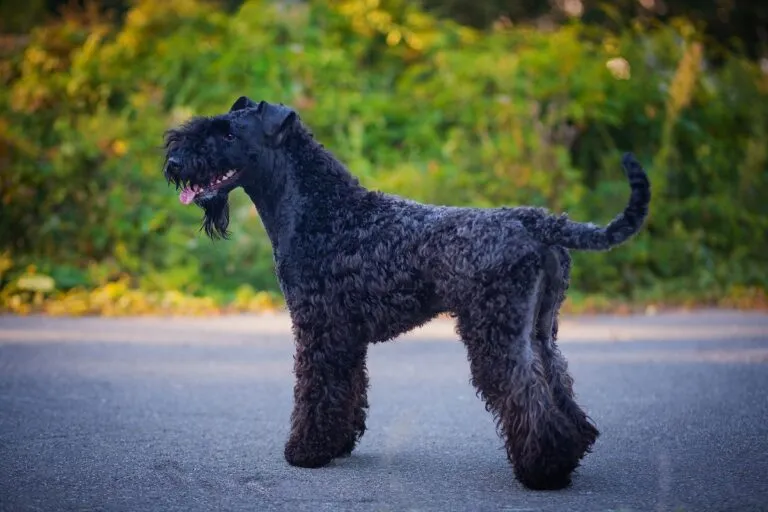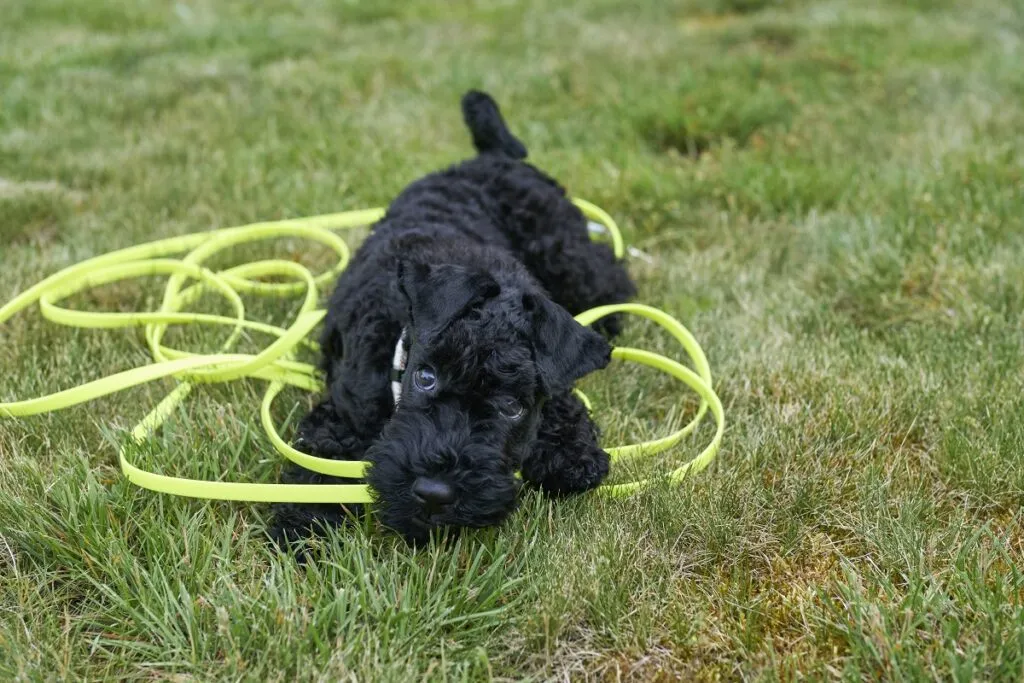Medium Size Poodle
The Kerry Blue Terrier is a breed recognised by the FCI for its prowess in hunting and as a guard dog. In its native Ireland, it has been used successfully for otter and badger hunts for many years. Though a determined companion for the hunter, the Kerry Blue Terrier is equally a loving family dog.

© savytska / stock.adobe.com
The energetic Kerry Blue Terrier needs at least two hours of exercise every day.
The Kerry Blue Terrier boasts a distinctive look. Its hallmark feature is its wavy to curly, soft and dense coat. The length of the coat can vary.
Its name derives from its steel blue to grey-blue coat colour, for which the breed standard permits certain nuances. Black markings here and there are allowed.
However, the dog only attains its typical colouring at 18 months. Puppies are born black or dark, but they possess a dominant gene for the colour change.
This change soon begins, leading gradually to a fading of the coat colour until the desired “Silver” or “Blue” tone is reached.
Did You Know? The Kerry Blue Terrier sheds very little hair and its coat generally doesn’t trigger reactions in people with dog allergies.
Physically, the Kerry Blue Terrier is a typical representative of the high-legged terriers. Standing at approx. 47 centimetres tall and weighing about 16 kilograms, it presents a muscular and athletic physique.
The animal’s skull is robust, heavily coated and often features a distinct, long beard on the snout. Its chestnut brown eyes offer a penetrating and perpetually vigilant gaze. The ears, small in stature, are prominent, tipping forward and folding over. From the shoulders, the terrier’s line sweeps towards the hips over a straight back, culminating in a high-set, erect tail.
 © savytska / stock.adobe.com
© savytska / stock.adobe.com
The Kerry Blue Terrier is a bundle of energy that’s always alert and attentive. Like all terriers, it stands out with a confident demeanour. It’s very friendly, affectionate, and loving towards its family.
Indeed, it’s very attached to its people and likes to be included in everyday activities. With strangers, reactions can vary from just as trusting to more reserved and watchful.
Aggression or persistent barking is rare. However, this doesn’t mean a Kerry Blue Terrier can’t assertively defend its territory!
Unlike some other terrier breeds, the Kerry Blue Terrier is highly compatible with children. It enjoys playing with little ones and shows an unusually high level of patience and calmness towards them.
Familiarise the dog with the offspring early on, so that the Kerry Blue Terrier can recognise the baby as a part of the family from the very beginning.
With other household pets, there can sometimes be challenges. It’s not impossible to keep a Kerry Blue Terrier along with a small animal, a cat, or another dog. Try introducing the animals patiently and carefully. However, keep in mind: It’s possible the Blue might not accept other animals alongside it.
The Kerry Blue Terrier is an active hunting breed and should be kept by those who are experienced with dogs. As with all terriers, the Kerry Blue Terrier demands attention, training, and leadership.
Even though the breed is very eager to learn, training is not always easy. Here, the stubbornness and strong will of the dogs come through!
The Kerry Blue Terrier is a very agile dog that demands plenty of exercise, freedom, and fun. Its energy level is quite high and it needs regular mental stimulation to stay balanced.
Twice daily, a lengthy walk accompanied by varied play sessions helps ensure the terrier remains content and at ease.
Due to its innate prey drive, caution is always advised. If a Kerry Blue Terrier picks up a scent, deterring it from pursuit might be difficult. On the flip side, it can thoroughly enjoy dog sports such as dummy training.
The Kerry Blue Terrier likes to work, but after that, its affectionate side emerges! It can be well-suited to apartment living, where it’s integrated into family life and doesn’t need constant attention. The Blue enjoys seeking out its favourite humans for a cuddle or to take a nap in their presence. It doesn’t fare well living in a kennel or garden shed: it needs its people close by.
The Kerry Blue Terrier isn’t fussy about food. It eats with gusto, accepting both wet food and dry food. Also, ensure your dog has continuous access to a bowl of fresh water.
However, you should always ensure that the amount of food corresponds with the dog’s exercise levels, age, and condition. No matter how much you feed – always do so before rest periods and never before a walk or playtime.
Divide the food into two daily portions to avoid burdening the stomach with too much food at once.
With raw feeding, the dog is fed fresh, homemade meat. This provides a very natural and healthy diet, avoiding unnecessary additives found in some commercial foods. Yet, this also represents a significant additional effort for the owner, both in terms of time and finance, and should therefore be carefully considered.
The coat care for the Kerry Blue Terrier is somewhat more complex than with other breeds. Since the fur often falls into their eyes causing irritation, you should trim it regularly in this area.
Many owners opt to clip the entire dog to simplify maintenance. If you like the long coat, brush the dog thoroughly with a suitable coat brush, especially after walks.
During regular excursions outdoors, it’s also advisable to maintain good tick protection since ticks can easily cling to the Kerry Blue Terrier’s curly fur.
The Kerry Blue Terrier is known for having very few health problems. It’s considered robust and only tends to develop skin and joint issues in its older years. In such cases, long-term overfeeding and obesity play a key role.
Specifically with dogs that come into contact with wild animals, you should become immediately alert to unusual behaviour and consult the vet. Serious infectious diseases or parasitic infestations may be present.
On average, breed representatives live 13 to 15 years.
The breed holds a long history, so ancient that the details have been swept away over time. What is certain is that the Kerry Blue Terrier has been used on Irish farms for generations for various hunting, herding, and protection tasks.
The first written mention dates back to the 18th century, describing it as a hunting dog. Since 1922, the Kerry Blue Terrier has been recognised by the FCI with regulated breeding, still emphasising its suitability as a hunting dog for badgers and otters.
Ireland’s Pride The Kerry Blue Terrier is one of Ireland’s national dogs.
If you’re looking to buy a Kerry Blue Terrier, expect to pay between 1,000 and 1,500 euros. Steer clear of significantly cheaper offers – they’re likely from dubious breedings without proper pedigree documentation or could even be involved in illegal trading.
The veterinary and maintenance costs for the breed are average since the Kerry Blue Terrier is neither particularly prone to illnesses nor does it require large amounts of food.
Before purchasing a Kerry Blue Terrier, think the decision through carefully. After all, you’re bringing home a new family member that will depend entirely on you.
The dog will need daily care, so it’s best to consider a plan B now if you’re ever indisposed. Who will take care of the four-legged friend? What happens if someone falls ill?
Once you’re confident, the choice of the breeder follows. Compared to other terriers, the Kerry Blue Terrier is less common. It may take a while to find a suitable breeder. Look for awards, certificates, or club memberships, but also trust your instincts.
Visit the breeding facility in person to assess the situation firsthand. Let the breeder enlighten you about the breed and their breeding practices.
You’ll soon notice: Do their breeding goals align with yours? If in doubt, seek another breeder and compare with a cool head.
The Kerry Blue Terrier is just that: a terrier. It comes with plenty of personality and a strong character – making it better suited for experienced dog owners.
Those up for the challenge will gain a courageous, attentive companion. Representatives of the breed are regarded as superb hunting dogs that protect their yard and family without unnecessary barking or aggression.
They are family-friendly and generally quite healthy. Their cheerful, playful nature is pleasantly complemented by affectionate moments.
| Special Features: | Medium-sized, muscular terrier with hunting and guarding instincts. Loves to work and play (including with children); bold and people-oriented, occasionally stubborn. |
| Character: | Lively, confident, loving |
| Height at Withers: | 45 – 48 cm for females, 48 – 50 cm for males |
| Weight: | 14 – 17 kg for females, 15 – 18 kg for males |
| Coat: | Abundant, blue to grey, curly |
| Coat Care: | Moderate, sheds little |
| Exercise Needs: | Significant, at least 2 hours per day |
| Suitable for Beginners: | No |
| Barking Tendency: | Average |
| Life Expectancy: | 14 years |
| Common Diseases: | Eye and skin diseases |
| Price: | £1,000 – £1,500 |
| FCI Group: | 3. Terrier |
| Origin: | Ireland |
Here are some purchase proposals curated by the zooplus editorial team
The products featured have been carefully selected by our editorial staff and are available at the zooplus online pet shop. The selection does not constitute advertising for the mentioned brands.
Fans of the Bearded Collie agree that those who aren't familiar with this dog breed simply have to get acquainted with it. And those who have experienced how a Bearded Collie bolts across meadows with its flowing fur, how it rolls around full of energy and joy and how it attentively and observantly takes into account its owners wishes become simply addicted to this original dog breed and its unique charm.
The Goldendoodle isn't a breed, but a pairing between Golden Retrievers and Medium or Standard Poodles. Marketed as a low-maintenance dog for allergy sufferers, this hybrid is enjoying increasing popularity amongst dog lovers, similar to the Labradoodle.